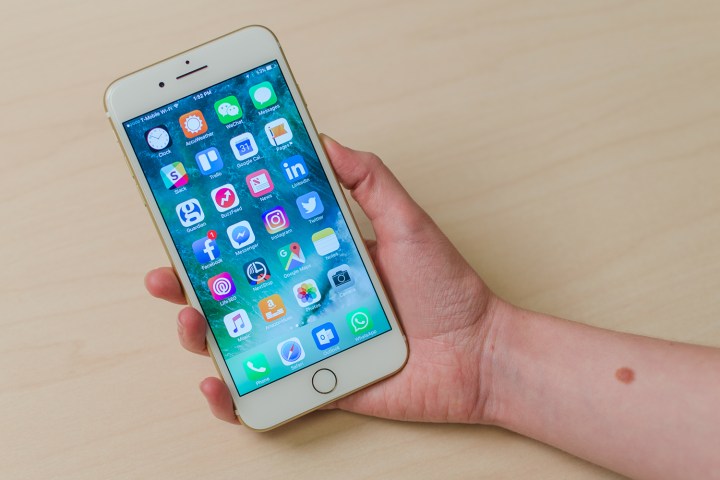
It was 10 years ago that the first iPhone, running the first version of iOS, hit the market. It had been revealed in a memorable keynote by the late Steve Jobs at MacWorld the previous January. He described it as “three revolutionary products… in one device,” combining “a widescreen iPod with touch controls, a revolutionary mobile phone, and a breakthrough internet communications device.” Few of us could have predicted the impact it would have — just look out our initial coverage of the announcement, if you need proof — though, it didn’t garner the following it now has overnight.
Let’s cast our eye back over the last few years and take a look at how the platform has changed throughout the course of the last decade.
iOS 1.0 — Touch controls, entertainment, and internet

What made iOS 1.0 special? The user interface was designed for multi-touch operation and the iPhone had a 3.5-inch capacitive touchscreen, which made it faster and more intuitive than any of the competition. It also offered a vastly improved mobile window to the internet (including the best version of Google Maps to date), and it encompassed everything that was good about the iPod. It wasn’t perfect, our review of the original iPhone bemoaned the lack of 3G, no wireless iTunes syncing, no external memory card slot, and no stereo Bluetooth, but that didn’t stop it getting an Editors’ Choice award and scoring 4.5 out of 5.
iOS 2.0 — Apps, apps, apps!

There had already been two updates when iOS 2.0 rolled out on the iPhone 3G in July 2008, and there would be many more, but this was arguably the most important for the platform because it ushered in the age of apps. The iOS 2.0 release brought the App Store and the SDK with it. The platform has been the first choice for mobile app developers ever since.
iOS 3.0 — Features galore

Lots and lots of little features rolled out to make the whole iOS experience, on the iPhone 3GS, that little bit more intuitive and smooth. We got push notifications for third-party apps, parental controls, tap to focus in the camera, in-app purchases and subscription models, universal search with spotlight, and cut, copy, paste for the touchscreen age. There was also the option to buy movies, TV shows, and books direct from iTunes on your iPhone or iPod Touch.
iOS 3.2 — The iPad

It was time for a major new device as the iPad burst onto the scene, and that meant new user interface and app designs to match the larger screen. It was more than just a resolution bump, extra panes and sidebar lists were introduced to make more use of the screen real estate. This was the first fragmentation in the iOS platform, as iOS 3.2 and its updates were only for the iPad.
iOS 4.0 — Multitasking, FaceTime, and folders

Alongside the iPhone 4 (the first iPhone with Retina Display), iOS 4.0 boasted “over 100 new features”. There was FaceTime for video calls, folders for organizing apps, universal spell check, unified email, and the headliner – multitasking. Apple’s interpretation of multitasking wasn’t the same as Google’s, but iOS 4.0 offered enough to fend off the challenge of the fast-improving Android platform.
iOS 4.0.1 to 4.3 — “Antennagate,” Game Center, and AirPlay

It was just a month before the first update rolled out to address the “antennagate” issue and another four updates were to follow over the next few months. iOS 4.1 introduced Game Center, AirPlay popped up in 4.2.1, Verizon support in 4.2.5, and finally personal hotspots to share 3G via Wi-Fi, AirPlay for third-party apps, and iTunes Home Sharing for Wi-Fi access to all your iTunes content in iOS 4.3.
iOS 5.0 — Siri, wireless sync, and iCloud

The iOS 5.0 platform and the iPhone 4S were important releases for Apple, with Android making serious gains in the smartphone market. There was plenty to capture the imagination as Apple showed a willingness to pull in great functionality inspired by competitors. There was an overhauled Notifications Center, the iMessage app, wireless activation, iTunes syncing via Wi-Fi, and over-the-air updates. The wireless theme was carried over into iCloud (an overdue replacement for MobileMe), but it was virtual assistant Siri that captured the headlines.
iOS 6.0 — Apple Maps, Passbook, and Facebook

At WWDC in 2012, iOS 6.0 was unveiled. It introduced some improvements, as always, and a couple of new features, but the big news was Apple Maps and the dumping of Google Maps as the default navigation service. It may have been a bit ambitious, and as various problems were highlighted, it prompted an apology from CEO, Tim Cook. It wasn’t all bad, though, as iOS 6.0 brought enhancements for Siri and the Notification Center, along with FaceTime over cellular, Facebook integration, and baby steps towards mobile payments with the new Passbook app.
iOS 7.0 — A fresh new look

Jony Ive introduced a completely new look for the iOS platform in 2013. There were newly designed icons, a simplified, flat design, with a new color palette, layers of stacked menus, animated backgrounds, and a depth effect on the wallpaper when you tilted the iPhone. New features in iOS 7 included Control Center (quick settings), Multitasking for all apps, a Safari update, a Siri update, AirDrop for sharing content, Camera update with built-in filters, a new Photos app that organized photos by location or date, automatic app updates, and car integration. There was also the new iTunes Radio service for music discovery and sharing.
iOS 8.0 — Apple Pay, Health, and Family Sharing

When iOS 8 arrived in 2014 it offered a handful of incremental improvements to the platform including a better keyboard, battery monitoring, and timelapse videos. It also enabled you to record audio and video in iMessages and brought widgets to the Notification Center. More exciting than that was the new health-tracking app, the ability to share content with your family, and the new iCloud Drive service. It also ushered in a more complete mobile payments solution in the shape of Apple Pay.
iOS 8.2 — 8.4 – Apple Watch and Apple Music

Apple fans pining for a new product finally got it when Tim Cook unveiled the Apple Watch in September, 2014. It didn’t go on sale until the following April, but it quickly became the best-selling wearable on the market. The iOS 8.2 update included support for the Apple Watch, though the device itself runs watchOS. The final update before Apple moved up to version 9 was iOS 8.4, which didn’t arrive until June, 2015, but it brought unlimited music streaming with it in the shape of the new subscription service, Apple Music.
iOS 9.0 — Smarter Siri, News, and Notes

There wasn’t really a big headline new feature in iOS 9. Siri got smarter as Apple introduced more intelligence and integrated Spotlight, offering up proactive suggestions for users. We also got a News app, Notes was much improved, Wallet replaced Passbook, transit directions were added into Apple Maps, and the iPad finally got split screen support. 3D Touch was a cool new feature, but it was limited to the iPhone 6S and 6S Plus. Bug fixes would follow, but iOS 9.3, released in March, 2016, also brought Night Shift mode to filter out blue light and help you get a good night’s sleep.
iOS 10 – Better Photos, Maps, and Messages

Apple billed iOS 10 as its biggest ever iOS release. Raise to wake brought the screen to life automatically with interactive notifications on the lock screen. Siri was opened up to third-party developers, so it could work in concert with apps like Uber, WhatsApp, and Pinterest. The keyboard grew more intelligent, with Siri suggestions weighing in with relevant details and multi-language support. Photos could now be filtered by location, facial recognition, and a number of other details, and it automatically clustered precious memories together into albums, creating a video of highlights. The Maps app was beefed up, Apple Music and the News app were redesigned, and there was a new Home app for home automation. Support for voicemail transcription and a host of improvements to the Messages app including new animations, music, photo, video sharing, and emoji suggestions, rounded out a big release for Apple.
iOS 11 — Things to come

The latest flavor of iOS brings the usual raft of small tweaks and improvements, along with a smattering of bigger changes. With the release of the iOS 11 public beta, Apple enabled peer-to-peer transactions via Apple Pay, redesigned the App Store, and introduced a slew of augmented reality features. The forthcoming release also touts a new, single-page Control Center, easy Wi-Fi sharing, a screenshot tool, a host of new photo effects, and AirPlay 2, which should help with multi-room alongside Apple’s forthcoming smart speaker, the HomePod. There are also a number of changes aimed at the growing iPad Pro family, including a new Files app, a Mac-style dock, improved multitasking, and drag-and-drop support. However, there is bad news for the iPhone 5S, iPhone 5C, and owners of the original iPad Mini — Apple will drop support for 32-bit products and apps in iOS 11.
Update: Added a new section detailing iOS 11, and refreshed the copy in commemoration of the iPhone’s 10-year anniversary.
Editors' Recommendations
- Best refurbished iPhone deals: Get an iPhone 14 for $513
- Best iPhone deals: Save on iPhone 15, iPhone 15 Pro Max and more
- iPhone SE 4: news, rumored price, release date, and more
- Best iPhone 15 deals: How to get Apple’s latest iPhone for free
- Best phone deals: Save on the iPhone, Galaxy Z Fold 5, and more

